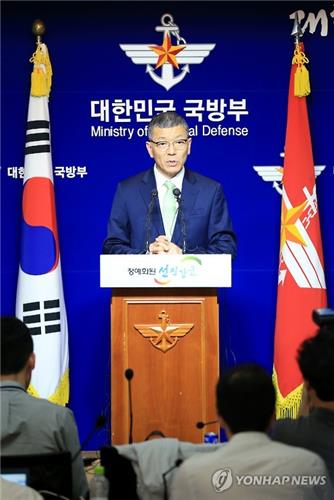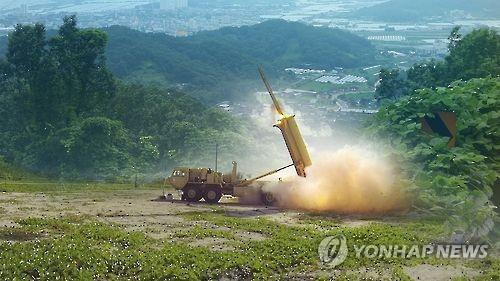- California Assembly OKs highest minimum wage in nation
- S. Korea unveils first graphic cigarette warnings
- US joins with South Korea, Japan in bid to deter North Korea
- LPGA golfer Chun In-gee finally back in action
- S. Korea won’t be top seed in final World Cup qualification round
- US men’s soccer misses 2nd straight Olympics
- US back on track in qualifying with 4-0 win over Guatemala
- High-intensity workout injuries spawn cottage industry
- CDC expands range of Zika mosquitoes into parts of Northeast
- Who knew? ‘The Walking Dead’ is helping families connect
S. Korea, U.S. pick southern county of Seongju to deploy THAAD
SEOUL, July 13 (Yonhap) — South Korea and the United States picked the mountainous southern town of Seongju as the location to deploy a Terminal High Altitude Area Defense (THAAD) system on Wednesday, as the allies are speeding up efforts to put in place the anti-ballistic missile shield to counter North Korea’s growing nuclear and missile threats.
“South Korea and the U.S.’ joint working group have proposed the Seongju area, North Gyeongsang Province, as the optimal place for the deployment … and the countries’ defense ministers have approved it,” the Ministry of National Defense’s deputy minister for policy Yoo Jeh-seung said in a press conference.
The placement of the THAAD system in Seongju, 296 kilometers southeast of Seoul, would help “more firmly secure the safety of our people living in two thirds of South Korea’s territory while dramatically increasing the capacity to defend key state facilities like nuclear power plants and oil storage areas as well as the South Korea-U.S. alliance forces,” Yoo noted.

The defense ministry’s deputy minister for policy Yoo Jeh-seung explains the government’s decision to deploy the THAAD in Seongju on July 13, 2016. (Yonhap)
In selecting the final location, the joint working group considered military effectiveness and resident safety as top priorities and conducted comparative studies, on-site inspections and simulations, according to the vice minister.
The allies announced their decision last week to deploy the high-tech defense shield in South Korea by at least the end of 2017. Yoo said the allies are striving to complete the deployment as soon as possible.
The mountainous region of Seongju got high marks for its location which can provide protection for key South Korean and U.S. military headquarters including Camp Humphreys, the new U.S. military base to which most of the 28,500 American forces stationed in South Korea will move by next year.
The town’s relatively remote distance from China, which bitterly opposes the deployment, has also apparently played into the decision.
The county is also located beyond the reach of North Korea’s long-range multiple launch rocket systems which have a maximum range of 200 km.
As the new missile system will be deployed in the southern part of the country, South Korea’s military plans to increase the deployment of its own Patriot medium-altitude missile interceptors in the populous capital area, Yoo said.
The medium-altitude Patriot interceptor system is more effective at countering North Korea’s missiles that fly shorter distances, thus at a lower altitude, he said.
South Korea and the U.S. first started their negotiations on the deployment in February in a bid to install a multi-layered air defense system against North Korea’s emerging missile capabilities.
In early February, North Korea tested its intercontinental ballistic missile before successfully test-launching its sixth Musudan intermediate-range ballistic missile last month, which could fly as far as the U.S. territory of Guam.
North Korea is believed to be in possession of some 1,000 ballistic missiles, and 85 percent are targeting South Korea, according to the South Korean military.
The THAAD system, also a major element of the U.S. missile defense shield, is designed to detect and destroy incoming ballistic missiles at an altitude of 40 to 150 km within a range of up to 200 km.
With the selection of the site, the allies will start the legal process to officially turn over the existing base in Seongju to U.S. Forces Korea for the THAAD deployment, Yoo said.
The unexpected selection of Seongju sparked angry resistance from its residents who believe the THAAD installation could pose health risks and inflict damage on the town’s oriental melon farming industry.
Leading an angry delegation, Seongju county chief Kim Hang-gon traveled to Seoul earlier in the day to lodge a protest with the defense ministry.
Kim demanded the defense ministry call off the site decision at a press conference in front of the ministry.
The ministry, however, maintained that the deployment will not have any hazardous health effects because the THAAD battery will be operated at a safe distance from civilians.
“The defense ministry will explain the facts (about the deployment), and once the people understand the truth the government expects the people to give their consent,” a ministry official noted.
Late Wednesday, Defense Minister Han Min-koo met with the angry residents and stressed that the THAAD system poses no health risks to them.
The site selection also came amid heightened tensions with North Korea over the deployment move. On Monday, North Korea threatened to take “physical” action against South Korea and the U.S. if the allies finalize their decision on the site.
“We once again warn the enemies that it is the steadfast will of the Korean People’s Army to make merciless retaliatory strikes to reduce South Korea to a sea of flames and debris once an order is issued,” the North Korean military’s artillery bureau was quoted as saying by the Korean Central News Agency.












